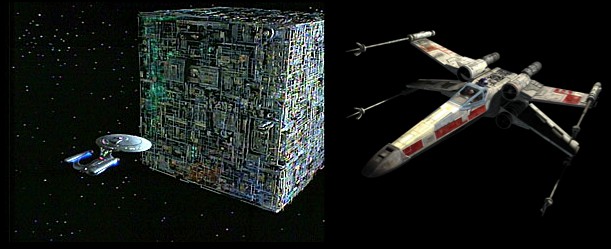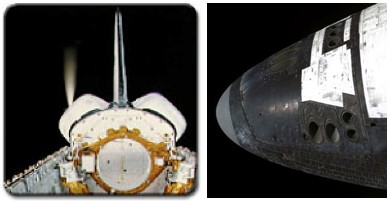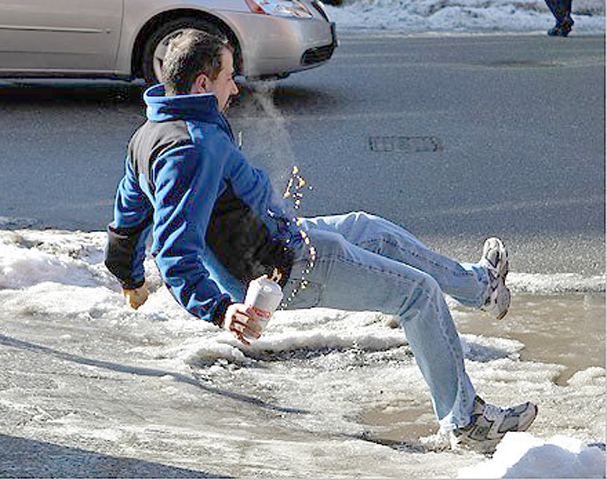Physicist: There’s more to this than you might think. If you’ve seen a movie involving spaceships of any kind, then you’ve probably seen the wrong answer. We’re used to thinking about airplanes (flying through the air) and walking (on the ground), so the basic intuition we have about how to move around (turning and starting and stopping) doesn’t apply in space.

In space it could barely matter less what shape your ship is, because it doesn’t interact or push off of air (left). Some epic sci-fi franchises choose to ignore that fact (right).
Every possible motion always conserves momentum, which just means “if you want to move, you need to push on something else”. Airplanes can bank in order to turn because they can push on air, and we can get up and walk across the room whenever because we can push on the ground. But in space those luxuries are missing, since there’s nothing to push on. Moving in space is the most frustrating damn thing ever. Think about trying to maneuver on infinitely slippery ice. Worse than that.
If you want to turn and face a new direction in space there aren’t a lot of options available to you. One technique is to literally throw things and getting a push from the recoil.

Maneuvering thrusters firing on the back of the shuttle (left) to pitch the nose up and different thrusters just sitting around looking pretty on the front of the shuttle (right).
If you want to move to the right you need to chuck a bunch of stuff to the left, and if you want to turn one way you have to chuck a bunch of stuff in the other. Flying around like an airplane in space doesn’t work at all (other than slowing down, this is a fair approximation).
However, if you just want to turn in space without moving (thrusters always push you around), you can “push on yourself”. This is how the Hubble telescope points at stuff. If it used tiny thrusters it would run out of fuel pretty quick (that thing is always looking at stuff) and it would pollute its tiny corner of space with exhaust. Instead Hubble uses flywheels, which run on electricity, to turn.

Turn a wheel in space, and turn yourself. Hubble has small flywheels (right) to turn, and tiny flywheels (left) to zero in on an exact direction.
Scattered throughout Hubble are an arrangement of little motors attached to basically nothing. Just by turning on those motors, and by spinning them in one direction, the entire craft turns (slowly) in the other direction.
So, if you want to move in space, you’ve got to move something else, and if you want to turn, turn something else.








We can the principle of ” Simple Harmonic Motion (S H M) ” just like the pendulum of a clock to control the direction of a ship in Space…. The pendulum attached at the base of a space-ship must be able to change the direction of a Space-ship (i.e. left, right, top and bottom)…. The pendulum must always attain to its mean position, and whenever it is required to change the Co-ordinate in space it will shift its position from mean to extreme !
Alright, I’m going to be “that nerd” and defend Star Wars for a second.
The Incom T-65 X-Wing starfighter is not only meant to operate in space, but in atmospheres as well. If you wish to criticize its design for being useless in space, you’d have to criticize the space-shuttle for the same reason.
Consider me nerd-slammed. That’s a good point.
So, the Hubble’s flywheels must be located very close to the center of mass, right? It seems like any eccentric motion would affect its orbit.
Concerning the Borg vehicle, aerodynamics are not a concern, but this is not the most efficient use of materials. To maximize contained space with a minimum of outer hull material, you would need to knock the corners off that thing. Maybe pressure vessels work differently in the Borg world.
@Morris
The location of the flywheels is fairly unimportant. Short of a rocket, the orbit is safe.
If a fire-hydrant were to burst it could potentially lift a car…so if some kind of machine were attached to a spaceship’s rear that generated a strong water current, could this push that ship? If this is even possible, what machine could keep this water-cycle going?
Unfortunately, hydraulics don’t provide too much advantage in space. You can certainly use water as the rocket exhaust, but the basic rule for exhaust, “faster=better”, holds.
Oh damn. I thought those flywheels on Hubble were for stabilizing it gyroscopically. In retrospective, nothing is there to destabilize the sat anyway.
Well have look around. Air, water, ground, all reaction mass/propellant. Living and working in free fall vacuum must be a serious nightmare.
fun fact, you can use flywheels as angular momentum banks simply by ‘turning a spinning flywheel’. the effect is basically that of a gyroscope.
a sufficiently large flywheel, once spun up, can have substantial angular momentum. if you re-orient the flywheel while it is spinning, the angular momentum changes with it, and due to the difference in angular momentum there is a secondary torque acting perpendicular to both the re-orientation torque and the angular momentum of the fly wheel.
you can set up a system of 2 pairs of co-spinning fly wheels (the pairs spin in opposite directions), and by changing the angle of the fly wheels you can manipulate the total angular momentum of the ship-flywheel system yielding rotation. you would need to keep the flywheels spinning at a controlled rate, as angling will likely slow them down.
When you mentioned “pushing on yourself”, it doesn’t sound right and seems to contradict what you said before about conserving momentum.
Reminds me of the “fan in the sailboat” physics problems.
Can a person suspended in space with nothing to push off of, turn themselves around?
If a spaceship pushes out air from within to surround itself, can it change direction?
@BlazeFlamer
A ship could briefly try to use sails or fins while the gas was around, but the gas would fly escape into space in very short order.
but if a space shuttle can release air and use its thrusters at a time on that air
it can move quite easily.
please I know there is a set contains a motor spinning around itself some thousand time in a minute to keep one direction even in space or on earth , how does it work ?
How does rocket actually fly? How does any thing goes up by applying the force on ground I mean
Like if we take a ball and throw it towards ground then will we actually fly or go in the opp direction in which the ball is thrown .
For example when we shoot from a gun we feel the force in the opp direction. But how does it happen Wat does it depend upon. Is it the energy we put on the ball or bullet has to be greater than our weight.
But from where do we get that energy?
It’s already inside us! Now let us assume we are in space and there is no gravity acting on us
If we shoot a bullet Wat is gona happen now.
_
— we will start moving in the opp direction We shot the bullet and this is how rocket changes its direction in space.
Now the main question is y does it happen y do we move in the opp direction?
We can understand this by this example — if we stand on a weighing machine and jump we will notice an increase and then decrease in our weight
That means we are applying force on ground to jump similarly when we throw some thing in space the object aply force on us to jump or move forward direction and when the object apply force on us we start moving in the opp direction
( conservation of energy ).
Again one more q comes —- Wat if there is no object in our hand and we simply do the action of throwing something will we start moving in that direction
No I don’t think so because there is nothing which is pushing us or neither we are pushing any thing so we will stay at the same position
Still thinking about this —— if we are in space the how much force is required for the object to make us move. Wat if the force in the object is very very less as compared to our body mass will we move
According to me yes we will move cause where else the force will pass or go but if it bouce back the energy is still conserved. Any of this is possible
But if we start moving when that small force hit us then the earth should also move when the rocket flies.
Wat if the force is greater than our body mass???
Suppose you were half way to Proximus Centauri going at say 0.7c and needed to return to earth quickly. Would there be any alternative to reversing the thrust till you reached 0.0c and continuing using the rocket power to get to, say -0.7c?
I presume that even if there were a planet like object, even a star, about you would be going too fast to get any more than a slight deflection.
To make the motor turn backwards you must reverse the current through either the rotor or stator windings, but not both.
What happen when thrust are as powerful as atomic bomb?
Yeah, yesterday I had my legs wet, and tried to pull my Jeans up so strongly that I hitted my head on the ceiling.. cmon guys, you can’t make this s up